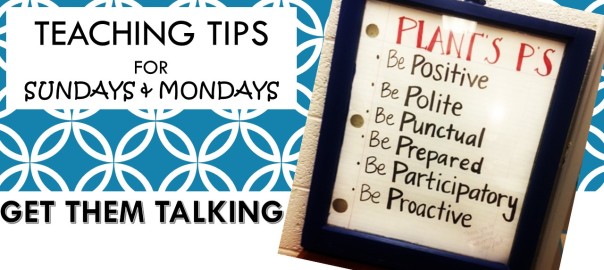Dear teachers of all places and all ages,
(That includes you, parents.)
I’m starting a new series, Teaching Tips: For Sundays & Mondays. I’d love for you to join me.
I know that good teaching happens in many places. It’s not just in our schools. It’s in various places such as Sunday Schools, employee training workshops, presentations, in the home, and more. As a fourth year teacher, I don’t consider myself an expert of experts, but I do believe I have come a long way since my student teaching and my first year of teaching. There are many books I have consulted, conferences I’ve attended, and teachers I have observed to help me become a strategic teacher. In fact, I still have a professor who emails alumni tips and tricks of the trade, plus writing opportunities; it’s awesome being an English Teaching Graduate from BYU.
One of my favorite books happens to be: Teach Like a Champion (By the way this is not an affiliate link; I genuinely love this book. Apparently they have a second edition out now). Its strategies have made a world of difference in my teaching techniques.
My friend, a community college adjunct professor, and I often talk about teaching and the needs of our students when we’re out walking. I used to live with two other teachers and carpooled with another. It’s safe to say that I just love talking to other teachers–in my own hallways, but also teachers of every kind and every age.
With my new series, Teaching Tips: For Sundays & Mondays, my goal is to share the best teaching strategies that I have found working in my classroom and in my lessons at church and in other professional presentations.
But before I share my first one, I want to point out the word “strategy.” Good teaching takes strategy; good teaching is intentional; and good teaching is an acquired skill. I’d argue that even the most naturally talented teachers have room to grow and probably have grown throughout the years. My tips are the strategies that work for me, that have helped me grow, and that continue to help me develop.
Good teaching takes strategy.
And so I invite you to read, follow, and share these posts and talk with me as well. I would love to hear what works well for you and who your best teachers have been. I would love to build a community of fellow teachers, teachers and parents of all kinds, who care about the children we teach and parent. I hope you enjoy #1!
TEACHING TIP #1 GET THEM TALKING
People like to talk about themselves, especially kids and teenagers, and even many adults. So no matter who you’re teaching this likely applies.

There are so many ways to have people talk in a meaningful way that can accomplish the purpose of your lesson. Sometimes you’ll want them talking as a hook (in place of an object lesson for example) or sometimes you may want them talking to explain something they learned from a particular activity. Don’t worry. I’ll give you examples of how both can be done.
Scenario #1: Students Talking As a Hook
Let’s say you’re trying to teach a lesson on how to choose a book well (an English Teacher’s favorite, and yes we still teach that in the 10th grade). Rather than jumping straight to the high and mighty importance of reading, ask students to start talking about their favorite movies. People love talking about movies right? As they are talking, you are doing two things. First, you are genuinely listening to their preferences and personalities, AND ALSO you are making a mental note to remember those answers so that you can refer to them when you are transitioning to the point of your mini-lesson. For example, when Bradley declares he loves The Fast and the Furious, you might “coincidentally” mention that when making a choice about what type of book to read, Bradley may want to look for an adventure or thriller book to begin with. Two things are going to happen: he’s going to look amazed that you heard what he said and remembered it AND ALSO be wondering how you somehow managed to relate it to R.E.A.D.I.N.G, that thing he’s hated since he figured out it’s not cool for boys to like reading. “How did she do that?” he’s thinking. It’s simple Bradley; she asked you a lead-in question, you talked, and she actually listened.
That scenario can be repeated time and again. High interest discussion questions are great hooks to get kids involved, engaged, and invested. Once you have their attention, which by the way is half the battle of teaching, you can begin to go somewhere with your content, no matter what that content is. If the teacher alone is doing all the talking through lecture or answering his or her own questions when met with silence, then the teacher is the one involved, the one engaged, and the one invested. That’s the beauty of talking. Whoever is doing it, is actually learning.
(I should note that talking doesn’t outweigh listening; it’s simply one of the strategies that works).
Scenario #2: Talking as a Response
Often times, teachers are so worried about “getting through everything” that they don’t leave time for a meaningful discussion. I will re-emphasize what I just said above: if the teacher is the only one talking, then he or she is the only one really learning. You have to plan adequate time for a discussion. Believe it or not, talking takes time, especially authentic talking. Susie needs time to share her opinion, Ben needs time to process it, and Tim needs time to respond. Instead of just the teacher lecturing or presenting information, at least three people in the room have engaged in the topic and you know it because you can hear it.
Now, to save time for talking or pause in the middle of content to debrief means that you have to be brave. I think for some shy people it’s scary to think about how to facilitate comments or they may be worried about things getting off track; however, if the teacher simply listens and responds, then he or she really can direct or redirect the conversation throughout meaningful interactions: that’s what facilitating is after all.
For example, in a discussion about the importance of professionalism in social media (keep in mind I teach 10th graders who will soon be applying for colleges before they know it), I may ask “so after having looked at what colleges value in an applicant, why would it be important to keep public spaces professional?” Suzie right out of the gate says “to hide anything bad.” Ben has his thinking face on, but Tim says “I don’t care what they think. I am who I am.” To which, you have listened and might respond with something like, “I think it’s important to be who we are Tim, but don’t you think it might hurt your chances if you advertise certain things?” Now depending on his personality, he may or may not change his mind, but that’s not the point. The point is that you know what he’s thinking about the content and the lesson because you’ve allowed him the time to involve himself, engage with the content, and invest his emotions in it. That’s the power of talking.
Getting them talking may seem like a no brainer, but planning meaningful discussion for various purposes has made such a difference in my teaching. I hope that one or both of these examples can help you the next time you teach. Be brave. All you have to do is ask a question and then listen. If you truly listen, you’ll know what comes next.
Happy teaching!
Sarah

P.S. If you liked this post, then you may like Learn Names on Day One. And as always, I’d love to hear from you. Like I said earlier, I learn from you just like I learn from my students.




I have always loved the idea of using the Socratic method to teach. When students are really engaged in the discussion they discover things for themselves. That is much more meaningful and will stick with them better. It also gives the teacher an insight into the learners mind. My girls are still pretty young so it’s hard to really use that method but letting them have time to talk where I listen helps me understand what they need and what they are learning. At this point it’s my main form of assessment.
Carrie,
You’re right. When they’re little, it is tricky to do the more sophisticated discussions like Socratic seminars, but at the end of the day, most forms of talking are an assessment. It even works in adult settings as well. Thanks for sharing!